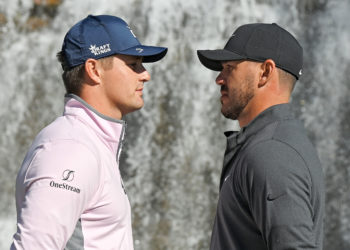Through his roles in “Taxi Driver” and “Goodfellas,” Robert De Niro helped define a particular vision of the city’s seedy underbelly, a gritty universe run by mobsters and underdogs. It’s no surprise that Mr. De Niro, a lifelong New Yorker, loves the city that has been a muse throughout his career.
Over the years, he’s invested in several businesses in Manhattan, opening Nobu and the Greenwich Hotel. Now, with his son, Raphael De Niro, and business partner, Adam Gordon, Mr. De Niro is fusing his passions for filmmaking, hospitality and New York with a 775,000-square-foot production studio in Queens.
“I have always loved shooting in New York. There’s no place like New York,” Mr. De Niro, 81, said in a recent phone interview.
Designed by Bjarke Ingels Group, Wildflower Studios opened for production in October. The hulking black building in Astoria houses 11 soundstages, each of which comes with its own suite of dressing rooms, lounges and offices. There are touches of luxury throughout — trucks offering drinks from Joe Coffee are scattered around the space, and there’s a turntable inspired by “Jay Leno’s Garage” for cars and wrap parties. But some elements remain personal — in the commissary, paintings made by Mr. De Niro’s father, the visual artist Robert De Niro Sr., line the walls.
The production studio’s arrival comes at a time when filmmaking in New York is in flux. Local employment fell after actors and screenwriters went on strike in 2023, and it hasn’t fully recovered. In June, there were roughly 47,000 people employed in the motion picture and sound recording industries in the city, compared with around 58,000 in June of 2022, according to the New York State Department of Labor. And many major productions in recent years have opted to film outside of the city, for cheaper labor and production costs.
But the De Niros hold an unwavering confidence in their project, in part because this year, Gov. Kathy Hochul of New York approved $800 million in film subsidies for productions in the state, nearly double the amount from 2022. “It’s always better to shoot in New York, period,” said Mr. De Niro.
This isn’t Mr. De Niro’s first attempt at creating a film studio in New York — he tried to open one in the Brooklyn Navy Yard in the ’90s, but the plan fell through. Now, decades later, a different version of that dream is realized, with grand scale and ambition.
‘They’re Going to Hungary’
Before Hollywood, New York first became a hub for filmmaking during the silent film era of the late 19th and early 20th centuries. But a more recent surge in movie production in the city was spurred by John V. Lindsay, who served as mayor from 1966 to 1973. Lindsay established the Mayor’s Office of Film, Theater and Broadcasting and loosened restrictions on filming on city streets. This led to the production of a slew of popular movies, including “Dog Day Afternoon” and “Rosemary’s Baby.”
Lindsay “made it much, much easier for films to be shot in New York, and the result was that suddenly there were a lot,” said J. Hoberman, a film critic and historian. That inspired certain genres, he added, noting that cop movies in particular were popular at the time. “New York was a great backdrop for these films, very stimulating,” he said.
During Lindsay’s two terms, more than 360 films were shot in New York, putting the city in all of its grit and glamour on display to audiences around the world. “For the first time, our parks and museums, our streets and courthouses, our libraries and monuments, all these things that make New York unique, have been made available to film people,” Lindsay noted.
But eventually, with rising costs and other locations competing to become motion picture production centers, filmmaking in New York dropped off.
Canadian cities were already popular alternatives in the ’90s when Mr. De Niro previously tried to open a studio in Brooklyn.
“There was a big rush to film particularly in Vancouver,” said Raphael, Mr. De Niro’s son. “My father was always very New York-centric — he had other interests in New York, a big extended family in New York — and he didn’t like the fact that he always had to be elsewhere shooting.”
Mr. De Niro “was also starting to direct films at that time, so he was looking at things a little bit differently and thinking more about physical production space,” Raphael said. “A Bronx Tale,” Mr. De Niro’s directorial debut, came out in 1993.
But Mr. De Niro’s studio plan fell through. Though the project originally had the support of Rudy Giuliani, who was mayor at the time, The Times reported that there were financing struggles. And, “there were some personality issues between some of the potential stakeholders,” Raphael said. The city found new developers for the project, which eventually became Steiner Studios.
In the past few years, filmmaking in the city took several hits, first the pandemic followed by the strike. And now, New York is in an affordability crisis affecting people across multiple industries.
The cost of shooting and living in major cities deters aspiring filmmakers from chasing after New York, said Andrew Moisey, the director of Cornell University’s visual studies program. “When I talk to filmmakers now and my own students who want to be filmmakers, I don’t hear any of them talking about wanting to go to Los Angeles or New York,” he said.
He continued, “the idea of even having a filmmaking mecca today, it doesn’t make a whole lot of sense if you can’t possibly pay all of the people that you would need. When they’re trying to shoot major films, they’re going to Hungary.”
‘An Unnamed Character’
The De Niros remain passionate about cinema created in and about New York. Raphael, who was a production assistant on “A Bronx Tale” before pivoting to a career in real estate, reminisced on his time working on the picture. “It was all shot in Astoria, even though it was intended to take place in the Bronx. Astoria had some low-slung residential neighborhoods that were actually perfect,” he said.
The city, he said, can be “an unnamed character within a movie.”
Located on what was part of the Steinway & Sons piano factory, Wildflower Studios is a revival of Mr. De Niro’s original idea for a production studio in New York, Raphael said.
Since the studio’s opening last fall, over a dozen projects, including television episodes, films and commercials, have been shot there, said Mr. Gordon.
“What we’re seeing more and more with the new film tax credit now is feature-length films, which didn’t happen as much in New York,” said Mr. Gordon. (Raphael and Mr. Gordon declined to comment on specific titles shot at Wildflower Studios.)
Nick Carr, a location scout, pointed out that part of the city’s appeal as a place to set films is that it’s multifaceted. It’s the hedonistic wonderland of strip clubs and mansions in “Anora,” it’s the downtown artists’ bohemia in “After Hours” and it’s the posh prep school society in “Gossip Girl.”
Mr. Carr said that Wildflower’s opening is “very good for my job, because the worst thing in the world is if you go to a city like New York and you can’t find your soundstages.” He explained that typically, for a project, shooting is split between on location and in a studio.
Several movies and shows set in New York have been filmed in Los Angeles, which has abundant studio space. Much of “Seinfeld,” for example, was made there. Having to fake New York from another city can be visually lackluster, Mr. Carr said: “You can do it, but as location scouts we just end up giving you the exact same five or six avenues in downtown Los Angeles that look like New York, and so it just looks the same, it looks fake, it looks contained.”
Mr. Moisey was skeptical Wildflower Studios would lead to a significant boost for filmmaking, pointing out that even though it does create more studio space, New York City is still an expensive place to live in. “You need to be able to rent space and house people,” he said. Many production companies continue to prefer other locations. Netflix, for instance, started construction this year on a 500,000-square-foot production facility in Monmouth County, New Jersey.
Still, for some, there is no replacement for filming in New York.
“There are some movies you just have to shoot here because of the buildings, the patois — it gives it an added kick,” said Nicholas Pileggi, the author of “Wiseguy,” the book he and Martin Scorsese adapted into “Goodfellas.”
Mr. De Niro spoke about the magical improvisations that shooting on a New York street can lead to.
“Marty Scorsese would take a guy drumming in the street, who’s a character that we’ve seen around the city a lot, and then all of a sudden Marty incorporates that into the movie,” Mr. De Niro said. “Music, someone singing, someone doing whatever they’re doing, it’s all stuff that’s unexpected. That life of the city, you know, you can’t create it, it’s just there.”
Anna Kodé writes about design and culture for the Real Estate section of The Times.
The post Robert De Niro Only Wants to Shoot in New York appeared first on New York Times.




